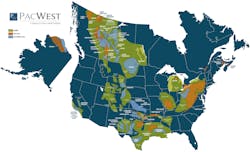Shale Plays Create Opportunities, Challenges for Automation
Crude oil production in North America continues to rise. 2013 saw an increase of a million barrels a day in the U.S., and production this year is expected to hit close to 9 million barrels a day, according to John Royall, president and CEO of Gulf Publishing.
Royall, giving an opening presentation this week at the Siemens Oil & Gas Innovations Conference in Houston, gave an overview of the North American and worldwide oil and gas scene, also outlining various factors in the industry and how they affect automation opportunities.
For example, industry activity has traditionally been measured by the number of rigs, but for the first time, analysts no longer think rig count is the most important thing to look at, Royall said. That’s because the rig count on average is going down, and yet footage drilled is on the rise. “With higher-efficiency rigs, we’re drilling much more footage with fewer rigs,” he said. “We’ll reach close to 400 million feet drilled in 2014.”
Growth of crude oil production in the U.S. is driven primarily by liquids-rich shale, and that is also changing the way the industry operates, with much more drilling happening horizontally rather than vertically. “The horizontal drills in the shale plays are getting longer and longer,” Royall said.
Horizontal is the name of the game these days, with horizontal well counts increasing by more than 6 percent this year, according to Chris Robart, a partner with PacWest Consulting Partners who followed Royall’s talk. Frac stage counts are at all-time highs, with more than 400,000 stages estimated for 2014. And horizontal frac stages represent about 87 percent of the total, he said.
The shale industry, with more wells in a smaller geographic area, produces on more of an industrialized, manufacturing model than conventional oil does. “It’s creating a lot of opportunities to sell better automation solutions,” Robart said. “It justifies spending money to do things more efficiently.”
But while the money is being spent, there’s pressure on suppliers to bring down their prices, Royall noted. Operators’ costs have grown faster than their profit margins over the past four years, he said, so they’re trying to achieve cost efficiencies in their operations.
Efficiency and cost are critical drivers in today’s market, Robart confirmed. The cost for a typical well has gone from $9 million to $10 million in 2010 to $6 million to $7 million today. In one extreme case, an operator in the Marcellus shale region brought its average well cost down 40 percent over two years, Robart added.
Efficiencies across the entire drill and completion value chain continue to improve, and the adoption of large-scale multi-well pad drilling continues to increase, Robart said. Also, increased lateral lengths and shorter frac stages continue to drive service intensity per well higher.
“Rig efficiency is sharply reducing the drilling days for nearly all plays,” Robart said. “Batch operations on multi-well pads are one of the biggest enablers of frac efficiency gains.”
The overall proportion of U.S. wells drilled on multi-well pads has nearly doubled since early 2011, Robart said, showing an example of a Halliburton multi-well pad that he described as a “massive manufacturing complex.”
Unconventional oil and gas presents many opportunities for technology-enabled efficiency and process improvement, Robart noted. “There are opportunities across the board to apply new technologies for increased efficiencies,” he said.
Robart summarized the opportunities for automation within oil and gas:
- Upstream oil and gas activity in North America is robust.
- Service intensity in North America continues to increase.
- Efficiency and cost will continue to be critical drivers in the market.
- Opportunities for industrial automation solutions continue to improve.
- Optimizing the production phase is the next big opportunity in North America.
- International unconventional oil is the next big opportunity—efficiency and innovation will be even more important in emerging markets.
About the Author
Aaron Hand
Editor-in-Chief, ProFood World

Leaders relevant to this article:
